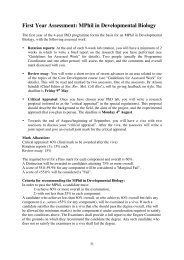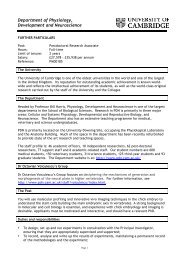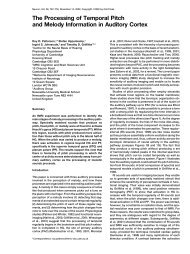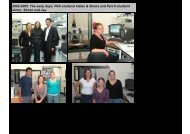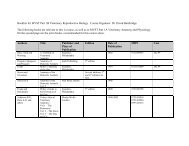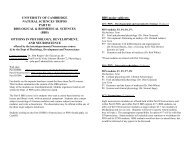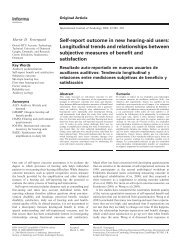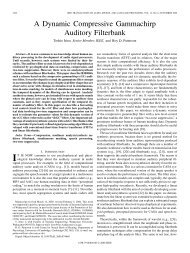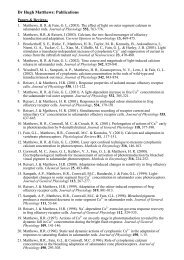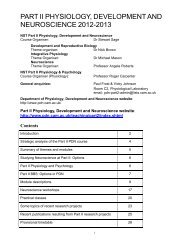FRIDAY MORNING, 20 MAY 2005 REGENCY E, 8:30 A.M. TO 12:00 ...
FRIDAY MORNING, 20 MAY 2005 REGENCY E, 8:30 A.M. TO 12:00 ...
FRIDAY MORNING, 20 MAY 2005 REGENCY E, 8:30 A.M. TO 12:00 ...
You also want an ePaper? Increase the reach of your titles
YUMPU automatically turns print PDFs into web optimized ePapers that Google loves.
given the simple geometry, and serves to illustrate how a source can perturb<br />
its field when near a boundary. Examples are presented for which<br />
significant changes in the pressure magnitude occur. Work supported by<br />
the Applied Research Laboratory, Penn State.<br />
11:15<br />
5aAA11. Subjective impression of differences in realism, source<br />
width, and orientation between auralizations created from multichannel<br />
anechoic recordings. Michelle C. Vigeant, Lily M. Wang<br />
Architectural Eng. Prog., Univ. of Nebraska–Lincoln, Peter Kiewit Inst.,<br />
1110 S. 67th St., Omaha, NE 68182-0681, mvigeant@unlnotes.unl.edu,<br />
and Jens Holger Rindel Tech. Univ. of Denmark, DK-28<strong>00</strong> Kgs. Lyngby,<br />
Denmark<br />
Auralizations can be very useful in the design of performing arts<br />
spaces. One of the fundamental modeling inputs to create auralizations is<br />
the source directivity. Standard methods involve inputting the measured<br />
source directivity, calculating the impulse response IR and convolving it<br />
with a single channel anechoic recording. This paper focuses on an alternative<br />
method of modeling source directivity which involves multichannel<br />
anechoic recordings to create auralizations. Subjective tests were<br />
conducted comparing auralizations made with one, four and thirteen channels<br />
for differences in realism and source width. Auralizations were made<br />
using three different types of musical instruments: woodwinds flute,<br />
brass trombone and strings violin. Subjects were asked to rate each<br />
musical track on a seven-point scale for the degree of realism and source<br />
width. An analysis of variance ANOVA was carried out to determine the<br />
differences between the number of channels and the effect of instrument.<br />
A second test was conducted to assess the degree of difficulty in detecting<br />
source orientation facing the audience or facing the stage wall depending<br />
on the number of channels one, four or thirteen and the amount of<br />
absorption in the room. Work supported by the National Science Foundation.<br />
11:<strong>30</strong><br />
5aAA<strong>12</strong>. Sampling methods for decay time evaluation in acoustically<br />
coupled spaces. Tomislav Jasa, Ning Xiang, and Mendel Kleiner<br />
School of Architecture and Dept. of Electrical, Computer, and Systems<br />
Eng., Rensselaer Polytechnic Inst., Troy, NY <strong>12</strong>180<br />
This paper applies the methods of Bayesian inference to the estimation<br />
of decay times in coupled rooms. Previous papers N. Xiang and P. M.<br />
Goggans, J. Acoust. Soc. Am. 110, 1415–1424 <strong>20</strong>01; 113, 2685–2697<br />
<strong>20</strong>03 developed a solution method to estimate the decay times and the<br />
number of decay modes in terms of measured Schroeder’s decay functions.<br />
This paper extends the previous work by using statistical sampling<br />
methods to efficiently determine the decay times along with error estimates<br />
and evaluate the ‘‘Bayesian evidence’’ term used in determining the<br />
number of decay modes. This paper discusses the implemented methods<br />
together with the previous work to solve the problem of decay time estimation<br />
as well as determining the number of decay modes in acoustically<br />
coupled rooms.<br />
11:45<br />
5aAA13. Experimental validation of a diffusion equation-based<br />
modeling of the sound field in coupled rooms. Alexis Billon, Vincent<br />
Valeau LEPTAB Univ. of La Rochelle, Av. M. Crepeau 17042, La<br />
Rochelle Cedex 01, France, abillon@univ-lr.fr, Judicael Picaut LCPC<br />
Nantes ESAR Rte. de Bouaye–BP 4<strong>12</strong>9 44341, Bouguenais Cedex,<br />
France, and Anas Sakout LEPTAB, La Rochelle, France<br />
Sound modeling in coupled rooms i.e., two acoustically coupled<br />
rooms separated by an open area has attracted considerable attention in<br />
the past. However accurate and operational models are still needed, principally<br />
when three or more rooms are coupled. In recent papers, a diffusion<br />
equation-based model has been applied to unusual room shapes. For<br />
the coupled rooms geometry, this diffusion model has been validated successfully<br />
by comparison with the classical statistical theory in a parametrical<br />
study of the coupling parameters Billon et al., J. Acoust. Soc. Am.<br />
116, 2553 <strong>20</strong>04. In the present work, the diffusion model results are<br />
validated by means of a comparison with experimental results, both in<br />
terms of sound attenuation and reverberation time. A comparison is also<br />
provided with results given by the statistical theory and a ray tracing<br />
program. For this purpose, experiments have been conducted in two<br />
coupled classrooms with two different sound source locations. The results<br />
show a very good agreement between the diffusion model and the experiments.<br />
Conversely, the statistical model is not valid for modeling accurately<br />
the sound field distribution and decay in both coupled rooms. At<br />
last, the diffusion model runs much faster than the ray tracing program.<br />
5a FRI. AM<br />
2581 J. Acoust. Soc. Am., Vol. 117, No. 4, Pt. 2, April <strong>20</strong>05 149th Meeting: Acoustical Society of America 2581



